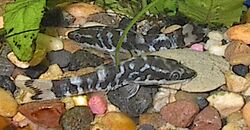Biology:Zebra oto
| Zebra oto | |
|---|---|

| |
| Scientific classification | |
| Domain: | Eukaryota |
| Kingdom: | Animalia |
| Phylum: | Chordata |
| Class: | Actinopterygii |
| Order: | Siluriformes |
| Family: | Loricariidae |
| Genus: | Otocinclus |
| Species: | O. cocama
|
| Binomial name | |
| Otocinclus cocama Reis, 2004
| |
The zebra oto or tiger oto (Otocinclus cocama) is a fish of the genus Otocinclus of the family Loricariidae that originates from Peru.
Taxonomy
The zebra oto was described in 2004 from a tributary of the Río Ucayali in Peru.[2] Its closest relatives appear to be O. huaorani, O. bororo, O. mariae, and O. mura, as well as the more recently described species O. batmani.[3]
Distribution and habitat
This fish is found in Peru in the Ucayali River and possibly Marañón River as well. These fish are found in mid-sized creeks with clear water. It may also be found in small ponds.[1] They associate with marginal vegetation.[2]
Appearance and anatomy
The zebra oto has a general body-shape like other Otocinclus species. They are small, have a suckermouth, and have armor on their bodies.
The zebra oto can be distinguished from all other members of this genus by its vertical stripe-like blotches and its complete lateral line. The zebra oto has the highest number of teeth of any species of Otocinclus. The W mark on its caudal fin distinguishes this fish from all others except for O. batmani. The zebra oto reaches about 4.4 cm (1.7 in) in SL, though the males are smaller.[2]
Status
The zebra oto is listed as endangered by the IUCN Red List due to its limited range and overexploitation for the aquarium trade. Additionally, it is not protected in any part of its range, nor is it listed on CITES. The species has a decreasing population trend in the wild.[1]
In the aquarium
The zebra oto has been for sale in the aquarium trade since the early 1990s. It has been popular since at least 2000.[2] They are an occasionally seen species, and are bred in Asia in good numbers.[4]
See also
- List of freshwater aquarium fish species
References
- Froese, Rainer and Pauly, Daniel, eds. (2011). "Otocinclus cocama" in FishBase. December 2011 version.
- ↑ 1.0 1.1 1.2 Hidalgo del Aguila, M.; Chocano, L. (2016). "Otocinclus cocama". IUCN Red List of Threatened Species 2016: e.T49829515A53817093. doi:10.2305/IUCN.UK.2016-1.RLTS.T49829515A53817093.en. https://www.iucnredlist.org/species/49829515/53817093. Retrieved 18 November 2021.
- ↑ 2.0 2.1 2.2 2.3 Reis, Roberto E. (2004). "Otocinclus cocama, a new uniquely colored loricariid catfish from Peru (Teleostei: Siluriformes), with comments on the impact of taxonomic revisions to the discovery of new taxa" (PDF). Neotropical Ichthyology 2 (3): 109–116. doi:10.1590/S1679-62252004000300001. http://www.ufrgs.br/ni/vol2num3%5CArtigo01_Reislowr.pdf.
- ↑ Lehmann, Pablo A. (2006). "Otocinclus batmani, a new species of hypoptopomatine catfish (Siluriformes: Loricariidae) from Colombia and Peru" (PDF). Neotropical Ichthyology 4 (4): 379–383. doi:10.1590/S1679-62252006000400001. http://www.ufrgs.br/ni/vol4num4%5CNI4(4)-379-383lr.pdf.
- ↑ Fenner, Robert. "The Ideal Algae Eater...". WetWebMedia.com. http://www.wetwebmedia.com/FWSubWebIndex/otocinclusart.htm.
Wikidata ☰ Q3754364 entry
 |


